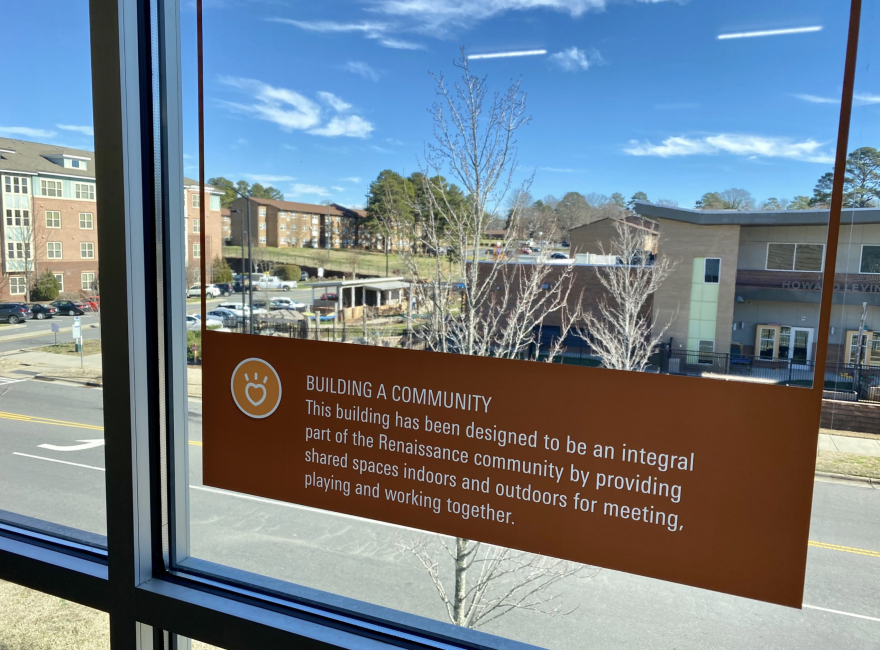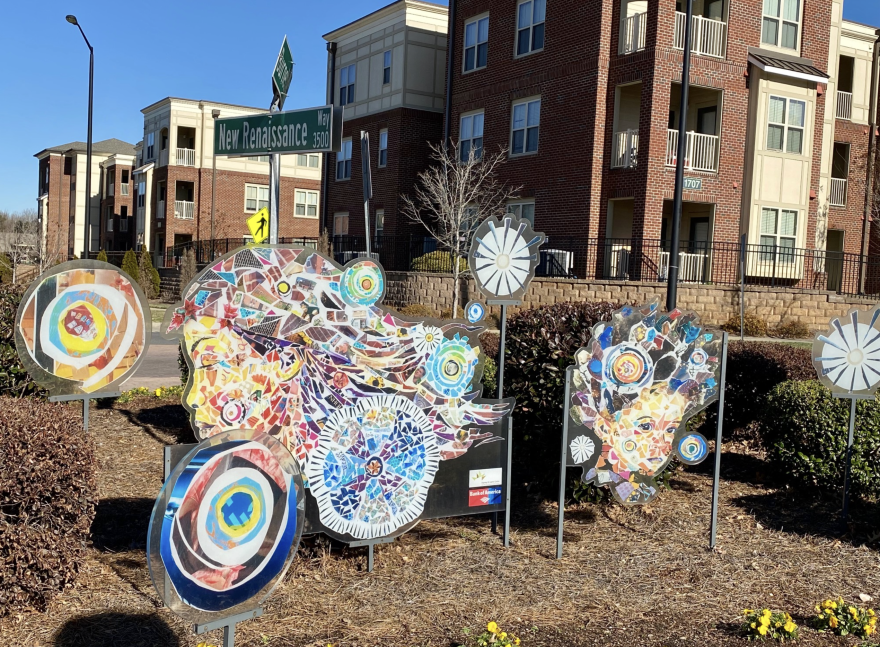This is the first in a three-part series about Renaissance West, an attempt to revitalize a west Charlotte neighborhood through an education village approach. Tomorrow: A look at the Atlanta neighborhood and charter school that inspired this approach.
You can read the story in Spanish here. (Puedes leer la historia en español aquí.)
Replace a dilapidated, crime-ridden public housing project with mixed-income housing. Add child care, a senior center and services for families. And make the centerpiece a school that can chart a path out of poverty for a new generation.
That was the vision when Charlotte’s civic leaders and neighborhood activists created the Renaissance West Community Initiative, a quest that began 14 years ago.
Sitting on about 40 acres just east of Charlotte-Douglas International Airport, Renaissance West represents one of the city’s most ambitious efforts to break the cycle of poverty. The work began well before a Harvard study that ranked Charlotte 50th out of 50 cities in economic mobility.
It’s located in what’s now known as the West Boulevard corridor of opportunity, an area that still struggles to claim a share of the region’s prosperity.
Public bodies and philanthropists have invested around $95 million, with more raised every year to support community services and the school.
Renaissance West is part of a national movement that strives to link high-quality schools with mixed-income housing and family support that can help multiple generations thrive. A decade in, there are visible signs of success and painful reminders of how difficult the work is.
‘Severe distress’
In the 1990s, Charlotte started tearing down public housing complexes and replacing them with townhomes and apartments designed to bring together the poor and the prosperous. Earle Village, Dalton Village, Fairview Homes and Piedmont Courts were all replaced with a mix of subsidized and market-rate housing.
A few years into the 21st century, officials were looking at their next project. They turned to a 300-unit complex on West Boulevard that had opened in 1970.
The Charlotte Housing Authority (now Inlivian) summarized the need in a 2009 application for federal funding: “Boulevard Homes’ severe distress is evident in significant building deficiencies, deteriorated systems, major site and design deficiencies, inaccessibility, concentration of poverty, and isolation.”
The application described tiny apartments with mold, asbestos and extensive physical decay. And Boulevard Homes was at the heart of a neighborhood where vacant buildings and substandard homes were common, crime was rampant and kids were failing in school.
Rickey Hall, a longtime West Boulevard activist and former chair of the Housing Authority, recalls that the housing complex was every bit as bad as the application painted it. Hall, who’s 66, says community residents had been pushing for better housing and opportunities since the late 1970s.

“At one point the West Boulevard corridor had the highest concentration of public housing in any one area, (and) the highest level of substandard and dilapidated housing. And a lot of the community leaders set out to change that,” he said.
A cradle-to-career vision
Charlotte’s leaders were starting to set their sights higher than just replacing buildings. In 2009 there was a communitywide book study about the Harlem Children’s Zone, a cradle-to-career approach to disrupting generational poverty by pairing school reform with housing and support for families. When the Foundation for the Carolinas brought Harlem Children’s Zone founder Geoffrey Canada to Charlotte, he drew a sellout crowd of 1,500.
So the Housing Authority’s application for a federal Hope VI grant to replace Boulevard Homes didn’t just pitch new housing. It outlined an education village with a high-quality childcare center and a K-8 school. The Charlotte-Mecklenburg school board promised to build that school.

Charlotte got the grant: Almost $21 million.
Laura Yates Clark, who was director of the Council for Children at the time, was hired to coordinate all the public and private players who would have to work as a team to make the project happen.
“We all were kind of like the dog that caught the car, right? It was a little bit of a Hail Mary. Nobody was really sure we’d get it, and then we did,” she recalls.
Once demolition was approved, about 900 people living in the 300 units at Boulevard Homes had to be relocated. News accounts from that time indicate that many were eager to get away from violent crime. The crime rate for Boulevard Homes was more than five times the city average.
Hope and skepticism
“Yes, there was some crime here. A lot,” recalls Gabby Riley, who was the final president of the Boulevard Homes residents’ association. “Sometimes you’d hear a lot of gunshots over here when I first moved here.”
She says she had lived in several Charlotte housing projects, including some that were demolished and replaced with mixed-income housing. For tenants, that often just meant being displaced.

“At first I was against it,” she says, “because I felt like I (had) seen them time and time again promise certain things and don’t deliver.”
When demolition began, Riley moved into different subsidized housing. Meanwhile, progress on the new community inched along. It was 2013 when housing for senior citizens opened, and a year later when younger people could move in.
Clark began her job as the Renaissance West CEO in 2013 as well. She said there was community support from such powerhouses as banker Hugh McColl and former UNC system president Erskine Bowles. But there was skepticism too.
“When I decided to take the job there were several community leaders that told me not to do it,” Clark said. “They said, ‘You’re going to ruin your career. It’s never going to happen.’ ”
Clark, who is now president of United Way of Greater Charlotte, says funders like to see concrete promises and a timeline. That was the approach taken by Project LIFT, a high-profile school turnaround effort that coincided with the Renaissance West launch. Project LIFT donors pledged about $50 million to reshape public education in west Charlotte in five years. Project LIFT got more attention than Renaissance West, but ultimately failed to deliver measurable results.

“The disinvestment over decades cannot be reversed in two or three or four or five years,” Clark said. “I think Charlotte wants quick solutions and easy wins. And these issues are just much more complex than that.”
So Renaissance West began its journey with the long view in mind. New housing went up, and Gabby Riley returned.
Most former Boulevard Homes residents had settled into different housing during the lag between demolition and reopening; Riley is one of five currently living at Renaissance West. She recently stood outside the site of her former apartment, proudly pointing out a gym, a swimming pool and playgrounds.
There are some residents who cause trouble, Riley says, but as for her fear that the new neighborhood wouldn’t live up to promises, “I had to eat crow,” she said. “Moving over here, I love it.”
Partnership with CMS
But even the community leaders who had resolved to be patient chafed at the slow pace of the education village. Peter Gorman, who was superintendent when the board agreed to build a school, resigned before plans were locked in.
The Renaissance West team looked at launching a charter school instead. But Heath Morrison, who became CMS superintendent in 2012, argued that a neighborhood public school would work better.
Clark, the former Renaissance West CEO, says community residents liked that plan.
“They weren’t quite ready to give up on CMS,” she said. “They felt like, ‘We were promised an equal education and we’ve been fighting for it ever since. And if we go the charter school route, aren’t we in some way saying we’re throwing in the towel?’ ”

A 2013 school bond package included $30 million to build the Renaissance West school. It wouldn’t open until August of 2017, and by that time two more superintendents had left CMS. Leadership churn — in the district and at the new school — would become a distinguishing characteristic of the partnership between CMS and the Renaissance West coalition.
The school is designated a STEAM academy. That stands for science, technology, engineering, arts and math. In some schools that label signals a robust menu of extras, such as robotics and science labs. But Renaissance West, which serves students from pre-kindergarten through eighth grade, has struggled with the basics. When it opened, the state reported that only one-third of kindergarteners arrived with the skills they needed. And at the end of that year, only 28% of the older students passed state reading exams.
Mack McDonald, who took over as CEO of the Renaissance West team in 2016, says the attendance zone included not only the mixed-income families coming into Renaissance West but other subsidized housing and low-income areas nearby.
“The way the boundaries were drawn we ended up with one of the highest-poverty schools in the state,” he said.
And that brought a familiar pattern: The school relied on Inexperienced teachers who didn’t stay long. Low test scores led to F ratings from the state. The first principal left after two years.
“And then,” McDonald says, “the pandemic hit.”
A quest for stability
With classes disrupted, kids who were struggling fell further behind. Educators left the profession, while schools fought for scarce substitutes and new hires.

Dwight Thompson became Renaissance West STEAM Academy’s third principal in 2021, as in-person classes resumed and schools tried to make up lost ground. He had been principal at Tuckaseegee Elementary, another high-poverty CMS school.
Thompson says he was excited by working with all the community partners. But he inherited a faculty where about 80% of the teachers had three years experience or less.
He focused on recruiting experienced teachers.
“I will interview on the weekend, I will interview at night. I advertise on Twitter, my Instagram, I post on LinkedIn, I have my team to post,” he said. “And so we just interviewed, like, nonstop.”
It paid off in hires like Sally Spencer-Hill, a sixth-grade math teacher with 15 years experience who took the place of a rookie.
“That was critical for me to get someone that has a track record of success and for them to actually be in the building here,” he said. “I had entire teams, entire grade levels previously that were first- and second-year teachers.”

Thompson also found little to distinguish the school as a STEAM program. Last year he added some dance classes to flesh out the “arts” part of STEAM. It wasn’t much, he said, but while kids were struggling to read and write, that was the best he could do.
The pandemic also disrupted North Carolina’s school performance grades, which are based on student test scores. They returned in 2022. At the end of his first year, Thompson’s kids showed enough growth to get off the state’s low-performing list. But proficiency levels remained below 20% in reading and math, and the grade was still an F.
In his second year, Thompson kept adding experienced faculty. All teachers got coaching. He felt like students were making gains, but he also felt pressure.
“I felt like, ‘OK, take a deep breath, Dwight. It’s OK. You can’t do everything in one moment,’ ” he said in February.
The kids took their 2023 exams in late spring. When that was done, Thompson made a summer trip to Atlanta to get pointers from leaders of an education village project that’s the model for Renaissance West.
This story was produced with support from the Charlotte Journalism Collaborative. WFAE is part of the Charlotte Journalism Collaborative (CJC), launched by the Solutions Journalism Network with funding from the Knight Foundation. The CJC strengthens the local news ecosystem and increases opportunities for engagement. It is supported by a combination of local and national grants and sponsorships. For more information, visit charlottejournalism.org.




